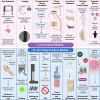Controversies in spine research: Organ culture versus in vivo models for studies of the intervertebral disc
- PMID: 36601369
- PMCID: PMC9799089
- DOI: 10.1002/jsp2.1235
Controversies in spine research: Organ culture versus in vivo models for studies of the intervertebral disc
Abstract
Intervertebral disc degeneration is a common cause of low back pain, the leading cause of disability worldwide. Appropriate preclinical models for intervertebral disc research are essential to achieving a better understanding of underlying pathophysiology and for the development, evaluation, and translation of more effective treatments. To this end, in vivo animal and ex vivo organ culture models are both widely used by spine researchers; however, the relative strengths and weaknesses of these two approaches are a source of ongoing controversy. In this article, members from the Spine and Preclinical Models Sections of the Orthopedic Research Society, including experts in both basic and translational spine research, present contrasting arguments in support of in vivo animal models versus ex vivo organ culture models for studies of the disc, supported by a comprehensive review of the relevant literature. The objective is to provide a deeper understanding of the respective advantages and limitations of these approaches, and advance the field toward a consensus with respect to appropriate model selection and implementation. We conclude that complementary use of several model types and leveraging the unique advantages of each is likely to result in the highest impact research in most instances.
Keywords: in vivo; intervertebral disc; models; organ culture; spine.
© 2022 The Authors. JOR Spine published by Wiley Periodicals LLC on behalf of Orthopaedic Research Society.
Conflict of interest statement
Lachlan J. Smith, Sibylle Grad, Victor Leung, Christine L. Le Maitre, and Devina Purmessur are members of the JOR Spine Advisory Review Board. The authors have no other relevant conflicts to declare.
Figures
References
-
- Hartvigsen J, Hancock MJ, Kongsted A, et al. What low back pain is and why we need to pay attention. Lancet. 2018;391:2356‐2367. - PubMed
Publication types
Grants and funding
LinkOut - more resources
Full Text Sources


